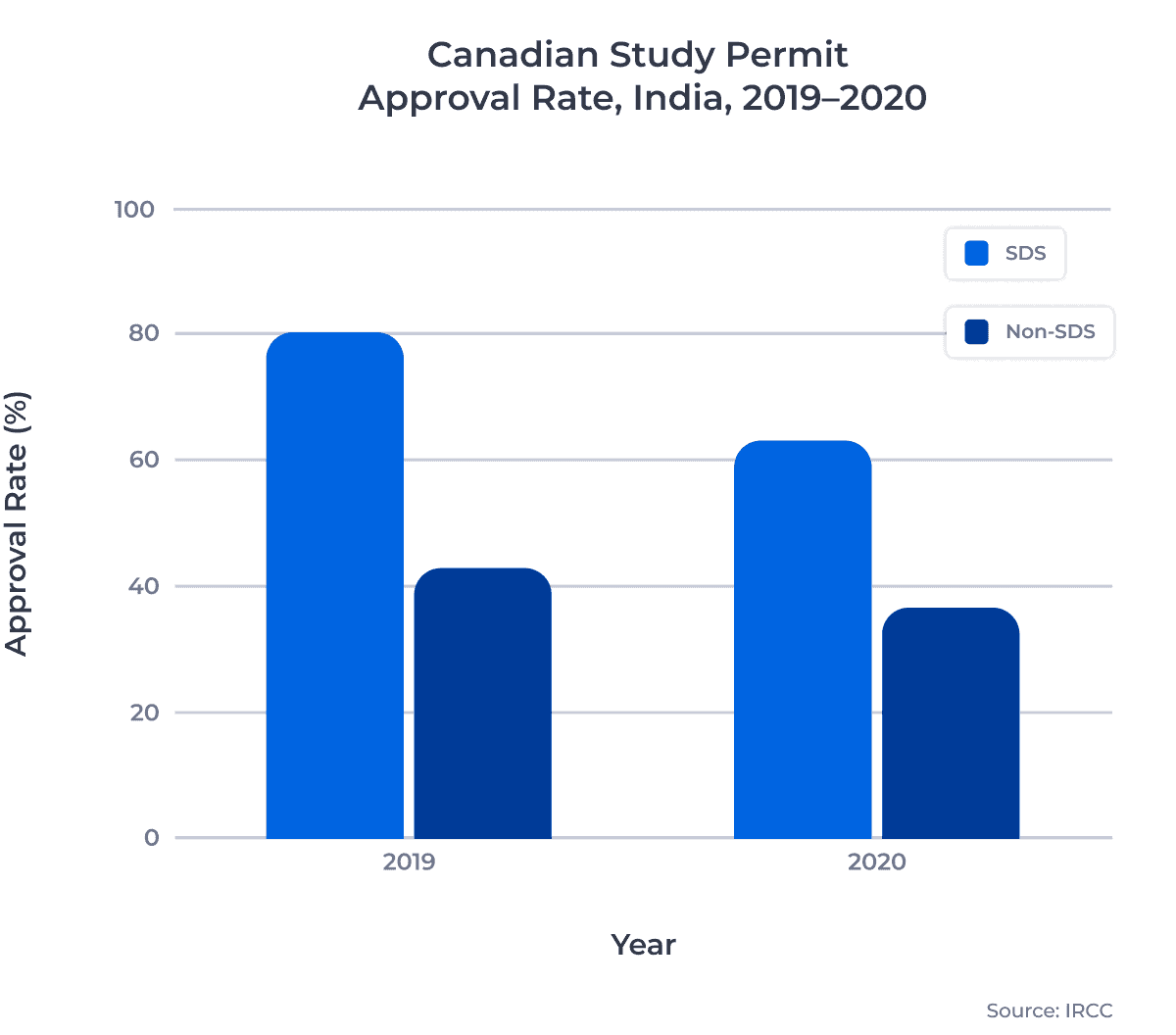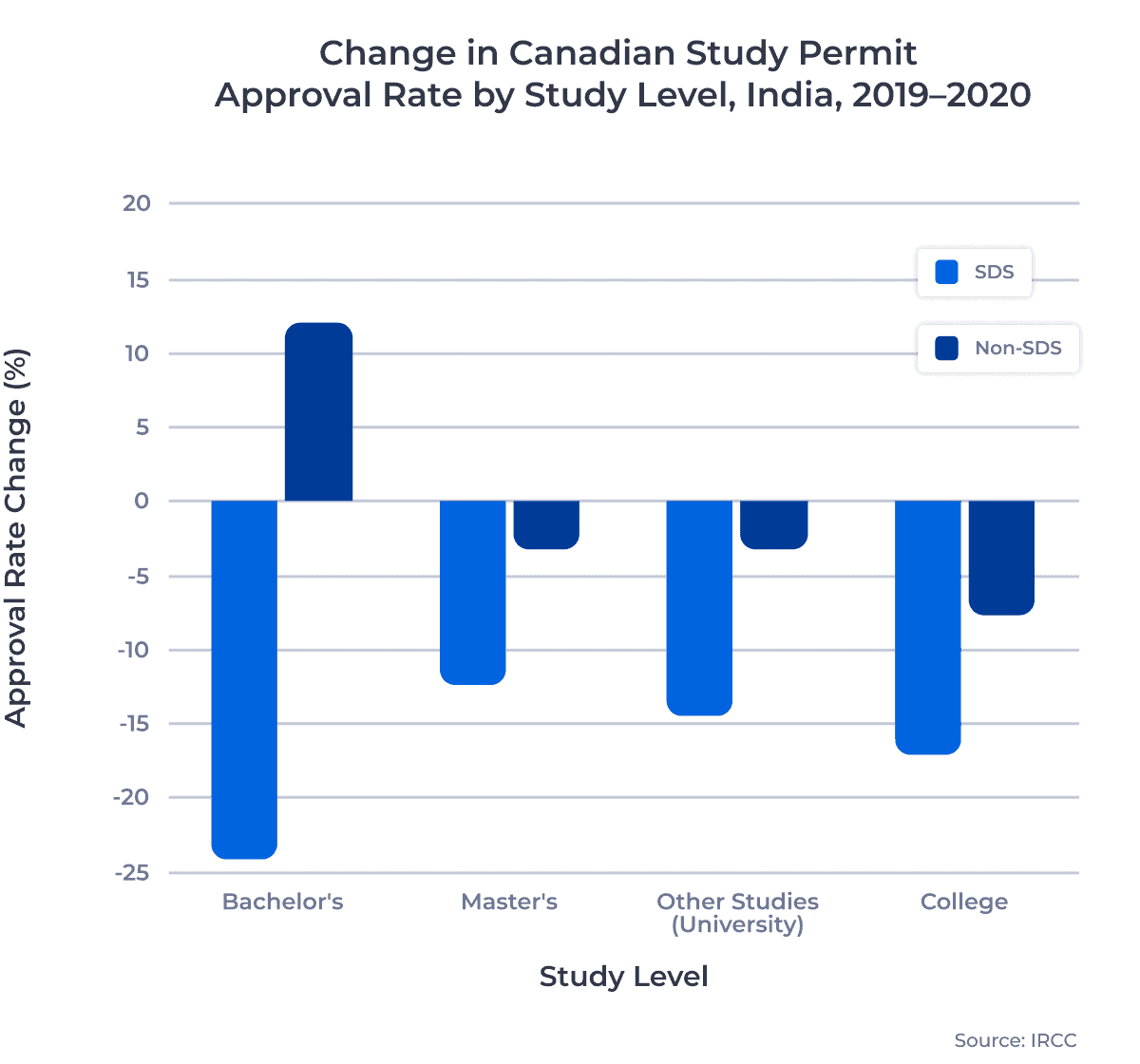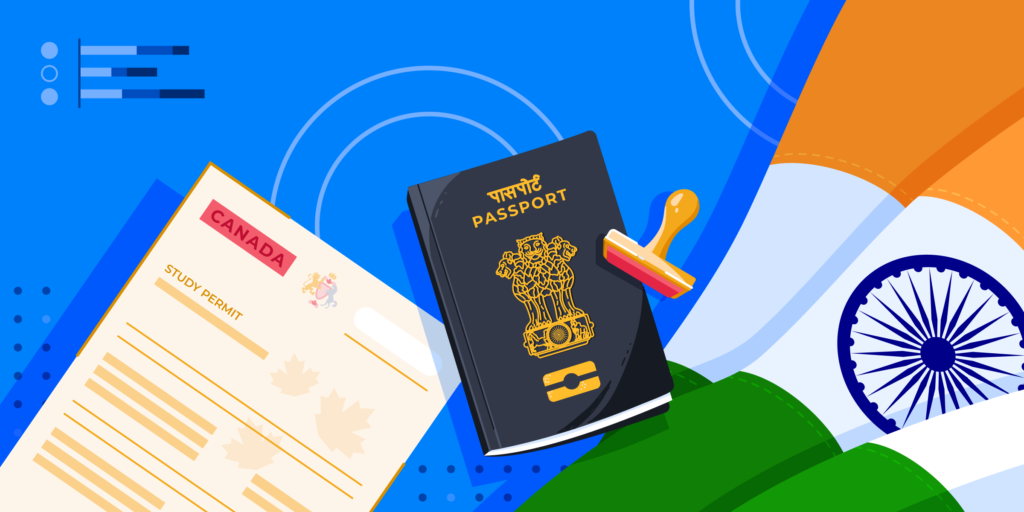In this edition of ApplyInsights, I’ll be diving into new data on Canada’s Student Direct Stream (SDS), a government program that allows eligible students from certain countries to expedite the processing of their Canadian study permit applications.
Previously, I compared approval rates for the SDS program and the regular study permit application stream in 2019 and early 2020. As markets around the world look to rebound from the global pandemic, it’s time to examine updated data1 and analyze the effect that COVID-19 has had on the SDS program. As 95% of last year’s SDS study permit applications came from Indian students, I’ll be focusing solely on that critical market in today’s blog post.
Key Insights at a Glance
- SDS remains an attractive option for eligible students, with a 63% approval rate in 2020.
- Study permit approval rates for bachelor’s programs under SDS dropped from 87% in 2019 to 63% in 2020.
- Substantially lower approval rates for SDS applications in 2020 were likely a product of non-student Indians attempting to use the SDS program to immigrate to Canada during the pandemic.
For those looking to get up to speed on what the SDS program is, learn more about the latest qualifications and application process, visit the Canadian immigration and citizenship resources on canada.ca.
Changes in SDS and Study Permit Approval Rates
Since the inception of the SDS program in 2018, Indian students have accounted for the overwhelming majority of SDS applications. In 2020, that trend persisted, as 33,370 of the 35,158 SDS applications came from the Indian market. Last year, 45% of all study permit applications submitted by Indian students were SDS applications.
The chart below shows the difference in study permit approval rates between Indian students applying through the SDS program and those who applied through the regular stream over the past two years:

While SDS approval rates fell from 80% in 2019 to 63% in 2020, the SDS program continues to offer students a much higher chance at getting approved for a study permit than the regular stream. Approval rates for the regular study permit stream declined from 43% in 2019 to 37% in 2020.
When I last examined SDS data, we found that Indian students who applied through SDS in 2019 were twice as likely to be approved for a study permit than those who applied through the regular stream. And while approval rates for both streams fell with the onset of the pandemic, this two-to-one ratio held through June 2020. Essentially, through June last year, the pandemic negatively affected both streams of applicants at the same rate.
However, something changed between June and December 2020 which affected full-year 2020 approval rates. The year-over-year approval rate for Indian SDS applicants fell by nearly three times as much as non-SDS applicants (-17% vs. -6%).
Changes in Approval Rates by Program
One of the core reasons students apply through the SDS stream is to expedite processing times, though higher approval rates are also attractive. In 2019, SDS approval rates were 35 to 45 percentage points higher than non-SDS rates across each study level. That all changed in 2020.
The following table summarizes the difference in year-over-year approval rates between SDS and non-SDS programs for Indian students:
| Study Level | Non-SDS Approval Rate | SDS Approval Rate | SDS Approval vs. Non-SDS Approval |
|---|---|---|---|
| College | 28.1% | 61.9% | +33.8% |
| Bachelor’s | 59.1% | 62.6% | +3.5% |
| Master’s | 66.5% | 79% | +12.5% |
| Other Studies (University) | 34.9% | 64.9% | +30% |
In 2019, the study permit approval rate for bachelor’s program applicants from India was 45 percentage points higher under the SDS program than under the regular stream. In 2020, that difference almost entirely disappeared, as bachelor’s program applicants under the SDS program had an approval rating only 3.6 percentage points higher than applicants under the regular stream.
While SDS applicants to master’s, college, and other studies programs all maintained higher study permit approval ratings over regular stream applicants, the advantage they held in 2020 decreased significantly compared to 2019.
By looking at the year-over-year change in study permit approval rate by study level, we can see how much less advantageous the SDS program appeared to be for Indian students in 2020:

Approval rates for Indian applications through the SDS program fell across every major study level in 2020, decreasing by 10 to 24%. Non-SDS applicants fared relatively well, only experiencing a slight dip in the master’s, other studies, and college approval rates.
One of the biggest shocks to me was the approval rate for non-SDS bachelor’s program applications rising by 12% in 2020. This bucks the trend that we’ve seen with our partner schools globally, as approval rates for bachelor’s programs fell by an average of nearly 6%.
Study permit approval rates for every major study level within the SDS program decreased by at least twice as much as approval rates for the regular stream in 2020.
Immigration Attempts via the SDS Program
To get to the bottom of this disparity, I spoke to ApplyBoard’s Senior Immigration Consultant, Hari Ghai. Hari is a Regulated Canadian Immigration Consultant (RCIC) and an expert on the SDS program.
India experienced arguably the worst COVID-19 outbreak of any country in the entire world. This led a lot of Indian citizens to explore avenues to get themselves and their families out of the country.
From what Hari has observed locally, applying for study permits has been a popular strategy used by Indians who are looking to kickstart the immigration process during the pandemic. Given that the SDS program is known to provide the best chance at study permit approval, Hari estimates that thousands of Indians looking to evacuate the country applied for a Canadian study permit via SDS in 2020.
The majority of these applicants were older, far removed from school, and would not have been viewed favourably by Canadian immigration officials.
High volumes of ineligible applications likely caused a massive decrease in the SDS study permit approval rate for bachelor’s programs last year, since bachelor’s programs are one of the most popular study levels for mature students without any post-secondary education.
While we can attribute a portion of the decrease in SDS approval rates to financial hardships and travel restrictions brought about by COVID-19, a significant number of rejections look to have come from “opportunistic” applicants. Taking this into consideration, approval rates for bona fide applicants likely didn’t fall nearly as much as the data suggests.
Advice to Prospective Indian SDS Applicants
The abrupt decrease we’ve seen in application approvals within the SDS program for Indians is a blip on the radar. When international travel from India to Canada resumes, I expect that the majority SDS applicants will once again be true prospective students, which will help approval rates to return to full strength.
Hari and other senior immigration consultants continue to advocate for students that meet the qualifications for SDS to apply for their study permits through this stream. However, he reiterates that SDS qualifications are not easily attained.
Among other things, SDS requires the following:
- An International English Language Testing System (IELTS) score of 6.0 or higher across all four categories of proficiency: reading, writing, speaking, and listening.2
- Proof of a guaranteed investment certificate (GIC) of C$10,000 or more.
Per Hari, all students, regardless of financial status or language proficiency, should see the SDS requirements as a bar to strive toward reaching in their application journey. Meeting these requirements gives them the best chance of getting approval in non-SDS programs, too.
If a student can’t afford the $10,000 GIC in Canada, they should look to improve their IELTS score as much as possible. If a student lacks proficiency in English or French but has the financial security to purchase a GIC, they should absolutely make that purchase. Each SDS requirement is a badge that makes students more attractive applicants, whether they apply through SDS or not.
Key Takeaways
Despite an uncharacteristically down year for the SDS program for Indian students, the program continues to provide bright opportunities for the most qualified students hoping to study in Canada. Here are some things to keep an eye on as a return to international travel peeks over the horizon:
- In 2022, I expect SDS application approval rates for bachelor’s, master’s, and college programs to regain their 25 to 45 percentage point advantage over the regular stream.
- If Indian students meet the criteria for SDS, they should make applying through the program a top priority since they are more likely to be approved.
- For institutions, they should ensure that online learning still factors into the curriculum once students are back on campus, but also that students still have access to the community and facilities that make the international student experience so unique.
Published: June 25, 2021
Subscribe to ApplyInsights
Sign up for the latest insights on international education.
 Meti Basiri
Meti Basiri
Co-Founder and Chief Marketing Officer (CMO)
Meti is driven by the belief that education is a right, not a privilege. He leads the International Recruitment, Partner Relations, and Marketing teams at ApplyBoard, working to make education accessible to people around the world. Meti has been instrumental in building partnerships with 1,500+ educational institutions across Canada, the United, the United Kingdom, and Australia. Working with over 7,500 international recruitment partners, ApplyBoard has assisted over 200,000 students in their study abroad journey. Follow Meti on LinkedIn for more access to ApplyInsights and key industry trends.
FOOTNOTES:
1. All data courtesy of Immigration, Refugees and Citizenship Canada (IRCC), except where noted.
2. For applicants to English-language programs. Applicants to French-language programs must provide a Test d’Evaluation de Français (TEF) score of at least 207 for reading, 310 for writing, 310 for speaking, and 249 for listening.



